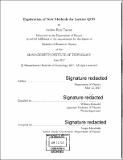| dc.contributor.advisor | William Detmold. | en_US |
| dc.contributor.author | Rios Tascon, Andres | en_US |
| dc.contributor.other | Massachusetts Institute of Technology. Department of Physics. | en_US |
| dc.date.accessioned | 2017-10-18T15:08:31Z | |
| dc.date.available | 2017-10-18T15:08:31Z | |
| dc.date.copyright | 2017 | en_US |
| dc.date.issued | 2017 | en_US |
| dc.identifier.uri | http://hdl.handle.net/1721.1/111884 | |
| dc.description | Thesis: S.B., Massachusetts Institute of Technology, Department of Physics, 2017. | en_US |
| dc.description | Cataloged from PDF version of thesis. | en_US |
| dc.description | Includes bibliographical references (pages 59-60). | en_US |
| dc.description.abstract | We explore two methods aimed at alleviating two difficulties in Lattice QCD: statistical noise and data storage. The first method intends to improve the signal-to-noise (S/N) ratio in three-point correlators, by extending previous work by Detmold and Endres. We test the method in the measurement of two observables: the nucleonic axial charge, and a matrix element computation related to the electromagnetic form factor of the rho meson. Only in the case of the rho we see a very slight improvement. We conclude that, in general, a case-by-case study would be needed to determine the effectiveness of the S/N optimization. The second method that we study aims to improve data compression of gauge fields. It consists in generating a set of matrices distributed roughly uniformly along the group manifold, and constructing fine lattices around each of these matrices. We show that this compression can indeed provide better performance for SU(2) and SU(3) than the Lie algebra compression, but the improvement is not very significant. Nevertheless, we show that it is fairly close to the best compression one could hope to achieve with this type of method. We find that the compression procedure is very costly, which makes it currently impractical for machine precision- compression. We conclude that studies must be done to determine if it can be improved by using additional information from the gauge fields. | en_US |
| dc.description.statementofresponsibility | by Andres Rios Tascon. | en_US |
| dc.format.extent | 60 pages | en_US |
| dc.language.iso | eng | en_US |
| dc.publisher | Massachusetts Institute of Technology | en_US |
| dc.rights | MIT theses are protected by copyright. They may be viewed, downloaded, or printed from this source but further reproduction or distribution in any format is prohibited without written permission. | en_US |
| dc.rights.uri | http://dspace.mit.edu/handle/1721.1/7582 | en_US |
| dc.subject | Physics. | en_US |
| dc.title | Exploration of new methods for Lattice QCD | en_US |
| dc.title.alternative | Exploration of new methods for Lattice Quantum Chromodynamics | en_US |
| dc.type | Thesis | en_US |
| dc.description.degree | S.B. | en_US |
| dc.contributor.department | Massachusetts Institute of Technology. Department of Physics | |
| dc.identifier.oclc | 1005077080 | en_US |
